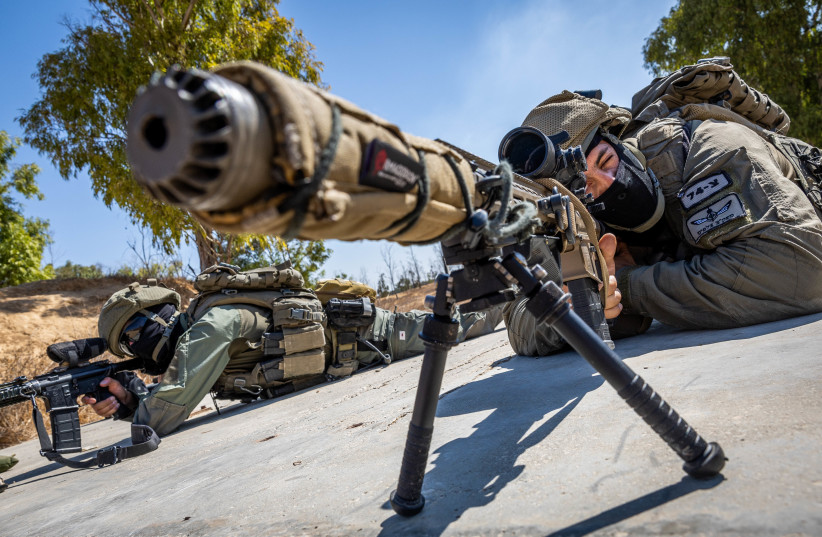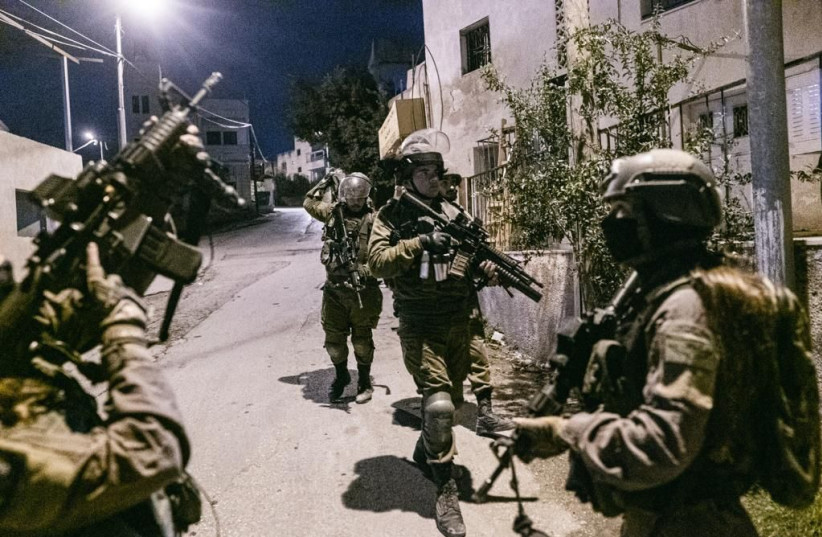The IDF’s ongoing Operation Break the Wave in the West Bank has seen thousands of troops and reservists crack down on Palestinian terrorism, arresting over 3,000 suspects and thwarting over 500 terror attacks.
The operation began in late March after a series of terror attacks in Israeli cities left 20 people dead. Israeli security forces, including the IDF, Shin Bet (Israel Security Agency) and Israel Police have been carrying out raids during day and night against Palestinians suspected of terrorism.
For more than six months, some 25 regular battalions have been deployed to the West Bank along with an additional 84 of reservists deployed to the area by the end of next year.
The large number of troops comes as the level of violence in the West Bank continues to remain unusually high, with massive amounts of gunfire directed against troops carrying out operational missions as well as against Israeli civilians.
The past year has seen a marked increase in terrorism, with 281 serious terror attacks by Palestinians: 239 against soldiers and 42 against civilians.

There were also a total of 8,483 violent incidents by Palestinians such as riots or stone throwings, about 40% of them against Israeli civilians and 60% against IDF troops. The number marked a significant rise of almost 20% from the 7,039 attacks last year.
But the need to crack down on terror has had a heavy price.
The operations in the West Bank have been the deadliest since 2016, with 136 Palestinians killed in the past year – almost twice as many as the 73 in 2021 and almost seven times the 20 in 2020.
The military says that the high number of Palestinian deaths stems from the fact that a massive amount of gunfire is directed toward troops during raids, leading them to fire back, many times killing the gunmen.
Along with the high number of Palestinians killed by Israeli forces, two soldiers and two officers have been killed during operations and another 15 civilians have been killed in attacks since Break the Wave began.
In addition to offensive operations against terror suspects, eleven battalions have been deployed to the Seam Line – the separation barrier that in some areas is a significant distance eastward in the West Bank from the Green Line – which saw thousands of illegal infiltrations over the years as well as the smuggling of guns and other weaponry.
The military has begun a large construction project costing some NIS 40 million to strengthen the Seam Line by building a 50 km. concrete barrier in the northern West Bank as well as a 15 km.-long barrier complete with obstacles in the Southern Hebron Hills.
With the large number of troops stationed along the Seam Line, the number of illegal infiltrations has dropped dramatically from 34,085 per week in March to 475 a week in November.
Sources have told The Jerusalem Post that the years without a strong barrier between Israel and the West Bank allowed for a significant amount of weapons to flow into the hands of gunmen.
DESPITE THE military attempting to crack down on illegal infiltration and weapons smuggling, the increase in shooting attacks has become a major source of concern for the IDF.
And with the IDF cracking down on weapons smuggling, there has been a dramatic 300%-400% increase in the price of ammunition and weapons. If, for example, a bullet for an M-16 used to cost NIS 3, it now costs NIS 20.
The prices for M-16s, Kalashnikov rifles and Glock handguns have also skyrocketed. An M-16 can cost between NIS 80,000-NIS 90,000 ($23,000-$26,000), an increase from NIS 70,000 ($20,000) in 2021. The cost of a Glock handgun has also increased from NIS 40,000 ($11,500) to NIS 50,000-NIS 60,000 ($14,500-$17,500).
The cost of these weapons is usually funded by terror groups including Hamas and Palestinian Islamic Jihad, which continues to funnel money into the West Bank to promote terrorism. During the operation, the military also confiscated 250 illegal weapons and more than NIS 2,700,000 ($780,000) in terror funds.

Though the military is operating throughout the West Bank, the focus has remained on the northern cities of Jenin and Nablus, where the Palestinian Authority Security Forces have been unable to clamp down on the violence.
About 25% of the population in Jenin identify with Palestinian Islamic Jihad while another 20% identify with Hamas. Both terror groups continue to invest in terror infrastructure in the cities, refugee camps and neighboring towns, providing money, training and more in order for supporters to carry out attacks.
While organized terror groups like Hamas and Islamic Jihad have not carried out attacks, they continue to incite the Palestinian street and instigate “lone wolves” to carry them out.
Lone wolves, who are not easily traceable to terror organizations, have been behind the majority of attacks in the past year, challenging security forces to locate and arrest them before they carry out their deadly plans.
While their ages vary, lone wolves are inspired by vicious incitement from social media networks and traditional media on television screens and radios. With the unemployment rate in the West Bank at 12%, many young educated Palestinians have no hope for the future and feel as though they have nothing to lose.